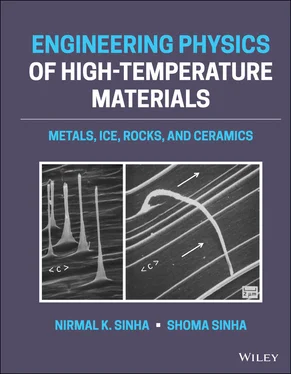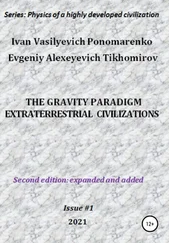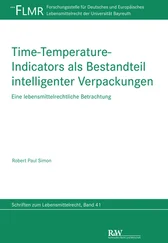Nirmal K. Sinha - Engineering Physics of High-Temperature Materials
Здесь есть возможность читать онлайн «Nirmal K. Sinha - Engineering Physics of High-Temperature Materials» — ознакомительный отрывок электронной книги совершенно бесплатно, а после прочтения отрывка купить полную версию. В некоторых случаях можно слушать аудио, скачать через торрент в формате fb2 и присутствует краткое содержание. Жанр: unrecognised, на английском языке. Описание произведения, (предисловие) а так же отзывы посетителей доступны на портале библиотеки ЛибКат.
- Название:Engineering Physics of High-Temperature Materials
- Автор:
- Жанр:
- Год:неизвестен
- ISBN:нет данных
- Рейтинг книги:3 / 5. Голосов: 1
-
Избранное:Добавить в избранное
- Отзывы:
-
Ваша оценка:
- 60
- 1
- 2
- 3
- 4
- 5
Engineering Physics of High-Temperature Materials: краткое содержание, описание и аннотация
Предлагаем к чтению аннотацию, описание, краткое содержание или предисловие (зависит от того, что написал сам автор книги «Engineering Physics of High-Temperature Materials»). Если вы не нашли необходимую информацию о книге — напишите в комментариях, мы постараемся отыскать её.
Discover a comprehensive exploration of high temperature materials written by leading materials scientists Engineering Physics of High-Temperature Materials: Metals, Ice, Rocks, and Ceramics
Engineering Physics of High-Temperature Materials (EPHTM)
Engineering Physics of High-Temperature Materials
Engineering Physics of High-Temperature Materials: Metals, Ice, Rocks, and Ceramics
Engineering Physics of High-Temperature Materials — читать онлайн ознакомительный отрывок
Ниже представлен текст книги, разбитый по страницам. Система сохранения места последней прочитанной страницы, позволяет с удобством читать онлайн бесплатно книгу «Engineering Physics of High-Temperature Materials», без необходимости каждый раз заново искать на чём Вы остановились. Поставьте закладку, и сможете в любой момент перейти на страницу, на которой закончили чтение.
Интервал:
Закладка:
The mantle is subdivided into an upper boundary marked by the Mohorovicic discontinuity, a lower boundary marked by Gutenberg discontinuity, and the core (also further subdivided into the inner core and the outer core). Discussions on these subjects are outside the scope of this book. However, we will consider the lithosphere and asthenosphere as one “solid” layer at various temperatures below the melting point of all rocks. The topic is rather complex because of the inhomogeneity in the structure and the melting point depends on pressure and mineral contents.
1.2.2 Trinity of Earth's Cryospheric Regions
The crustal surfaces of Earth have seen numerous cycles of glaciation and thawing. These cyclic events were interactively influenced by the “Trinity of Earth's Cryosphere.” Three sections of the cryosphere act as the cooling vent for the earth.
Trinity of Earth's Cryosphere
NORTH POLAR ZONE
HIMALAYA (Alps, Andes, Rockies, etc.)
SOUTH POLAR ZONE
The Arctic region containing the North Polar Zone and the Antarctic region containing the South Polar Zone are the primary cryospheric regions of the world. The secondary cryospheric regions are the Alps, Andes, Himalaya, Rockies, etc. The Himalayan belt covers the largest effective area among the secondary cryospheric regions.
Earth's atmosphere depends on a number of complex issues and factors, such as its rotation around its geometrical axis, angle of the rotational axis, the annual path around the sun, the geography of the continents and their mountains, and oceans and ocean floors. Solar radiation certainly plays the most important role in shaping Earth's surface environment. According to the position of the Sun throughout the year, Earth can roughly be divided into three distinct areas consisting of five zones: (i) tropical zone around the Equator, (ii) two temperate zones, and (iii) two polar zones.
On two equinoxes, 21 March and 23 September (depending on the leap year), the Sun is directly overhead at the Equator and its rays just reach the North Pole and the South Pole at the same time of the day. The Sun is directly overhead at the Tropic of Cancer on 21 June (summer solstice) in the northern temperate zone and at the Tropic of Capricorn on 22 December (winter solstice) in the southern temperate zone. In the polar zones, respectively, the Sun never sets in their summer and never rises in their winter. The Arctic region containing the North Polar Zone and the Antarctic region containing the South Polar Zone are the primary cryospheric regions of the world. The secondary cryospheric regions are the Alps, Andes, Himalaya, Rockies, etc. However, the Himalayan belt covers the largest effective area among the secondary cryospheric regions. Long‐term climate change (see Chapter 10) has been affecting all the cryospheric regions of the world. The effects are directly observable and can be quantified using, among other methods, ice core analysis and snow as the messenger of the sky, the global environment, and the ground below, including volcanic eruptions in the past (see Section 11.3, Chapter 11).
It is important to mention that all the secondary cryospheric regions of Earth, irrespective of their size and shape, were produced as a result of plate tectonics. These regions are not stationary and changing with time. The characteristics of these regions and their time dependency are linked closely to the rheological properties of rocks at high temperatures. Consequently, the development and spread of human civilizations on the global surface centered around various locations were/are influenced strongly by the high‐temperature properties of rocks governing plate tectonics.
The ice‐rich polar region around the North Pole and the South Pole covers the major cryospheric area of the total global surface. The oceans cover about 70% of Earth's surface, and about 15% of Earth's surface is covered with sea ice at one time or the other (Shokr and Sinha 2015). The polar regions influence the global ocean and atmosphere in a profound manner. The temperature of the oceanic surface influences climatic changes occurring year after year. Within the South Polar Zone, south of the Antarctic Circle, nobody lives and only a few small communities of Falkland Islands and Argentina consider the Antarctic region as their home. In the Northern Hemisphere, north of the Arctic Circle, in circumpolar areas of Alaska, Canada, Norway, and Russia, perhaps a few million people live. However, nearly 1500 million and more people living in Afghanistan, Bangladesh, China, India, Nepal, Pakistan, and Tibet are directly affected by the secondary cryosphere of the Himalayan region.
The Himalayan belt has two distinctly different faces – the North and the South – where outstanding human cultures developed and continue to flourish. Both sides are subjected to the similar cycle of water transport from rainwater for three months during monsoon season to meltwater from seasonal snow deposits and glacier, groundwater, and evapotranspiration for the rest of the year. The biodiversity of the two sides is particularly noticeable. From the arid semidesert with loess deposits of the west to the Bohai in the east, the Yellow River “used” to make a 5400 km journey. On the south side, the Indus, Ganges, Yamuna, and the Brahmaputra travel toward the Arabian Sea and Bay of Bengal, but these rivers are drying up and/or getting heavily polluted. “Fresh water” has been and will continue to be the main issue for the Himalayan belt and the world. In comparison with about 70% of Earth's surface covered with saline oceans, only 3% of the global water surface is fresh and confined mainly in the Great Lakes in Canada and the USA, and the Caspian Sea and Lake Baikal in Russia. Shortage of fresh water in rivers and that of groundwater have impacts on agriculture, economy, health, energy, and geopolitical issues. Instead of debating cross‐boundary differences between the nations and using technology to control nature, we have to adopt new ways for our survival. Moreover, knowledge of ice as a material can also help in removing cross‐disciplinary barriers separating the physics of materials science of solids at high temperatures.
1.3 Earth's Natural Materials (Rocks and Ice)
The top section of Earth's crustal layer mainly consists of water, rocks, and ice. Rocks, depending on their types and mineral contents, have components of crystalline and amorphous phases. Plummer and McGeary (1985) provide a simple, but comprehensive, description of geology that will be useful for readers. Silica (SiO 2) is the most abundant component of rocks, and the common extrusive rocks are classified into silica‐rich (felsic) rocks and silica‐poor (mafic) rocks. Ice or the solid state of water (H 2O) is crystalline and belongs to the hexagonal system in Earth's crust; however, individual ice crystals are extremely pure because ice lattice is very intolerant to inclusions. Water, of course, is a liquid with amorphous structure, but oceans in the Arctic and Antarctic regions can be “ice rich” (often described for wrong reasons as “ice‐infested”), depending on the season.
Interestingly, viscous molten rocks or magma at extremely high temperatures at great depths below Earth's surface could be similar in behavior to ice‐rich water (specially with thick layers containing frazil ice crystals) on Earth's crust. The structure and fluidity of magma depends on location, depth, and temperature. As temperature and pressure decrease with decrease in depth, the viscosity of magma and its constitution change. The viscosity of the mass depends on its structure, because different types of crystals form depending on the eutectic points and float, separated or trapped within the melt, and are extruded if possible. Structural features of magma are very complex simply because of pressure, thermal state, and different mineral contents with wide‐ranging concentrations. It is impossible to conduct in situ studies of magma, but laboratory investigations are often performed on quenched melts or glasses of simple compositions as analogs (Henderson et al. 2006; Greaves and Sen 2007).
Читать дальшеИнтервал:
Закладка:
Похожие книги на «Engineering Physics of High-Temperature Materials»
Представляем Вашему вниманию похожие книги на «Engineering Physics of High-Temperature Materials» списком для выбора. Мы отобрали схожую по названию и смыслу литературу в надежде предоставить читателям больше вариантов отыскать новые, интересные, ещё непрочитанные произведения.
Обсуждение, отзывы о книге «Engineering Physics of High-Temperature Materials» и просто собственные мнения читателей. Оставьте ваши комментарии, напишите, что Вы думаете о произведении, его смысле или главных героях. Укажите что конкретно понравилось, а что нет, и почему Вы так считаете.












